All about the parrot cockatiel

An Australian inhabitant, the cockatiel parrot (another name is a nymph), is a member of the cockatoo family and belongs to the order of parrots of the genus Nymphicus. In their natural habitat, these birds nest in forests or shrubs located on the banks of rivers and reservoirs. Sometimes they visit semi-desert plains and steppe areas with herbaceous vegetation. Wild cockatiels are shy: to quench their thirst, the parrot flies close to the surface of the water and takes several hasty sips in an upright position.

The main food for birds is grass seeds and small insects. On eucalyptus trees, nymphs feast on the nectar of inflorescences, and when wheat ripens in the fields, parrots pay a visit there and peck grains with pleasure.
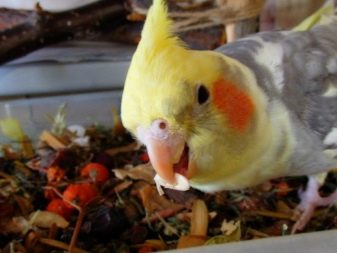

Description
The cockatiel parrot is a small bird, its size, taking into account the tail, is 30–35 cm. The tail is long - 15–16 cm - and pointed at the end. The weight of an adult cockatiel is 95-110 grams. In a parrot, feathers grow on the back of the head, forming a crest, a curved beak, small in size. Adult males are brighter in color than females. The males have a feather color in rich gray-olive shades, the cheeks are a bright orange-yellow color, and the tuft is yellow.
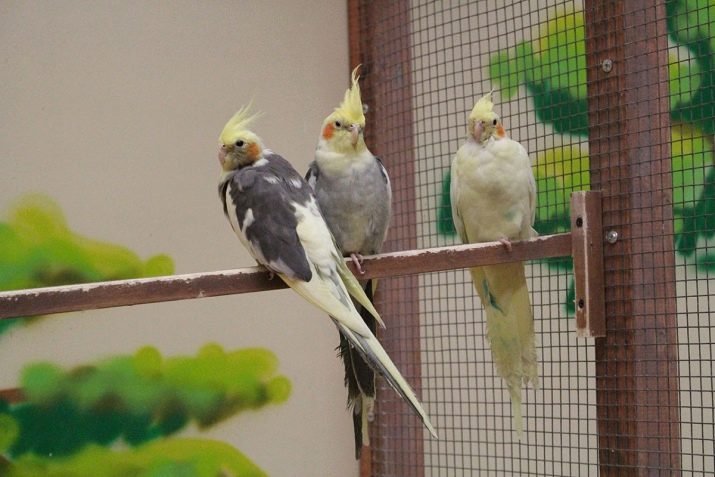
The female is colored more modestly - her feathers are of the usual light gray color, the cheeks are pale brown, and the crest and head are pale gray with a yellowish tint. Young chicks of either sex have the same coloration as an adult female. Flight and tail feathers have light yellow oval spots. On the outside of each rudder, there is a yellow stripe on the underside. If the chick is male, then when it grows up, the yellow spots and stripes disappear from it, but from the females they remain.
The color change of feathers occurs one year after birth.

In the wild, the nymph breeds during the rainy season, when there is a lot of food for adult parrots and their offspring. Since cockatiels are awake and sleeping in trees, they prefer to equip their nests in the same place, choosing hollow areas inside dried branches. During the rainy season, parrots have time to lay two clutches of eggs.
Each clutch contains from 3 to 7 eggs. The egg looks ordinary - it is white and up to 2 centimeters in size. Both parents hatch eggs - within 21 days the male replaces the female. By the end of the incubation period, small chicks covered with yellow fluff appear. The female and the male take part in feeding the babies also alternately. Chicks leave the nest after 5–6 weeks.

During the feeding period of the first brood of chicks, the female lays the next clutch of eggs, and the whole process is repeated from the beginning.
Cockatiels have adapted well to captive breeding, and over time it was possible to breed breeds that differ from each other in plumage color. The life span of a parrot in the wild does not exceed 10-15 years. Birds live in groups of 10-50 or more representatives. Parrots tend to flock during the breeding season or during prolonged droughts. In captivity, with proper care, nymphs can live up to 25 years.

Colors
Due to the fact that the nymph reproduces well in captivity, ornithologists and breeders have managed to breed various subspecies of these birds, differing from each other in the color of their plumage.
Characteristics of the most common types.
- White paint - birds have black eyes, main plumage with a pronounced yellow tint. In males, light feathers grow in the region of the undertail and there are a couple of such feathers in the tail. The female's tail feathers are all light, and in the undertail area, according to the basic color tone, we will see a marbled light yellow pattern.

- Albino - the eyes of birds are red due to the fact that there is no pigmentation at the genetic level. The feathers of the nymphs are white or with a light cream tint, but the feathers on the head, including the crest, are yellow in color, and the cheeks are orange. In albino males, the whiteness of the feathers is more pronounced than in females. Females may have yellowish spots on the wings, in the undertail.

- Light gray color - black eyes, feathers of a pale gray color. This subspecies was obtained by crossing gray and white species, therefore, the nymph of a light gray color inherited all other signs from a gray species - a yellow head and crest, orange cheeks, light tail feathers.

- Lutino color - the eyes are red, and the color of the feathers is yellow. White feathers can be seen on the wing, and very bright orange spots on the cheeks.
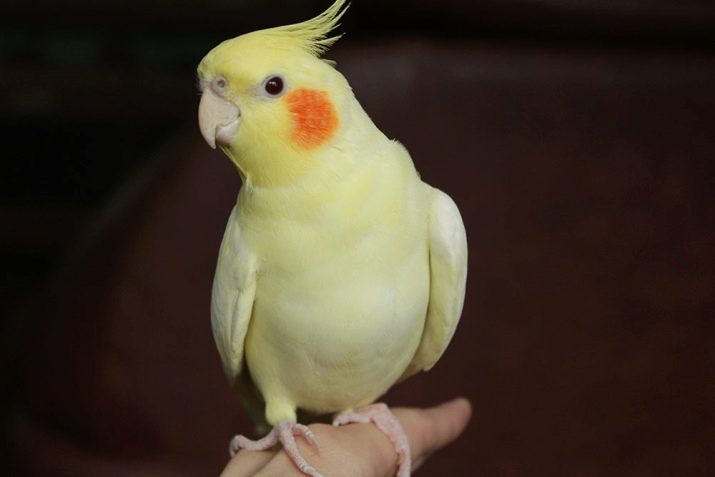
- Cinnamon color - This subspecies has a dark beige color of the main feathers, and on the head there may be yellow feathers and a tuft of the same color. The cheeks are yellow in females and orange in males, the tail feathers of the wing are light yellow. Parrots have black eyes.

- Dark yellow color - is a type of cinnamon color. The plumage ranges from light cream shades to deep yellows. In the process of species mutation, it is noteworthy that only gray feathers change color, while the rest of the color remains the same as in gray cockatiels.
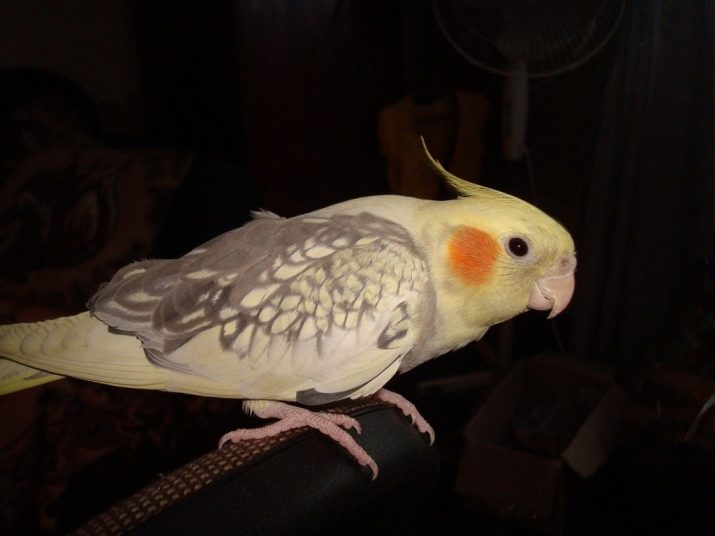
- Coloration of the neck - the peculiarity of the color is that there are blotches of white on the plumage of the parrot. The most valuable is an individual in which the spots are symmetrical while maintaining equal proportions of the main shade and white.

- Pearl-variegated color - the edges of the feather plates are dark, and the central area is white or pale yellow. The intensity of the base color ranges from dark to light shades. The base color can be gray or cinnamon. Only females retain this color for life. Males lose the expressiveness of color contrast during molting.
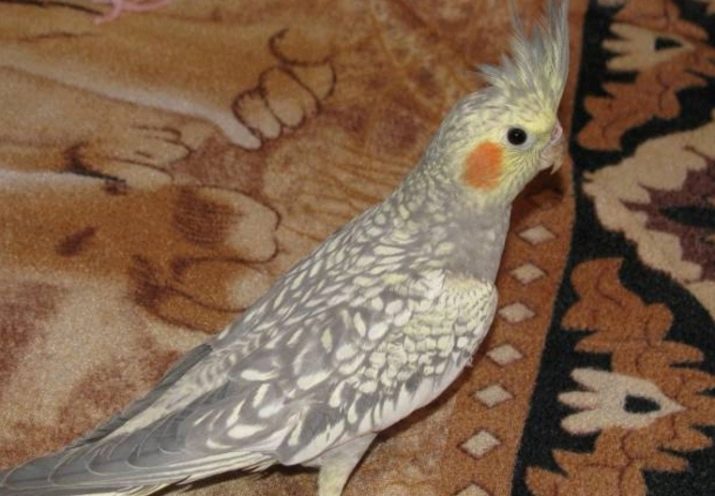
- Motley silver color - the feathers of these birds, at first glance, are the same, light, but upon closer examination you will see on each feather two shades - white and pale gray. The intensity of this combination in different subspecies varies from very light tones to darker ones. Cheeks, crest and head with a silver color have a yellowish or creamy tint. There are species in which the cheeks remain orange in color.

- White face - the head and tail feathers are white, while the rest of the feathers are gray or cinnamon. In white-faced species, there is no pronounced coloration of feathers in the cheek area. The crest usually has the same color as the bulk of the feathers, but only of a lighter shade.

- White-winged species - it is characterized by the fact that when colored, like an ordinary gray nymph, white-winged parrots have white feathers in the wings.

- Black winged view - with ordinary gray plumage, there are feathers of a darker color on the back, in the area of the tail and wings. On the wing of a black-winged species, you will always see a spot of a whitish hue. Males and females of this species differ little in color from each other.

In fact, there are a very large number of types of color nymphs: white-faced mottled cinnamon, pearl gray, pearl cinnamon, pearl lutina, white-pearl and so on. In a number of countries, there are already exhibition standards for the color of cockatiels.... It is in nymphs, in comparison with all other parrots, that the largest number of plumage color options is recorded.

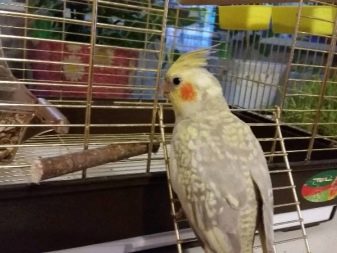


How to choose?
It is better to buy cockatiels in a pet store, where they are sold from trusted suppliers, having passed veterinary control. They come to the store in the morning or in the evening and observe the nymphs at the time when they are most active. This should be done so as not to attract the attention of the bird - for this, stand not far from the cage.
A healthy individual behaves actively - she is interested in food, toys, neighbors in the cage, and even what happens outside of it. If the bird is lethargic and indifferent to everything, then this is a sign of its ill health. Sometimes a parrot can just sleep and you will see that it sits on a perch, holding on to it tightly with one paw.

Before buying, inspect the appearance of the parrot by taking it gently in your hands. Make sure that all the feathers are in place, there are no bald spots, sores on the body, feathers are not tousled and lie smooth. Look at the paws - all toes should be in place, whole and healthy. Moving on to the beak - outwardly it should look smooth, without damage, with a correct, tight closure; we immediately look at the nasal passages - in a healthy nymph they are dry, without discharge.
The eyes of a healthy bird are always bright, shiny, without watery eyes.


Pay attention to how the bird eats. If she actively searches for food and eats it, this is a good sign. Look at the droppings - it should be thick, while sick birds have watery droppings.

When choosing a cockatiel, pay attention to its behavior. If you want to find a parrot that will be friendly and will make contact with you, pay attention to the most active, noisy and curious individuals, they willingly allow themselves to pull themselves together. Best of all, nymphs get used to a person at the age of 5 to 6 weeks. It happens, of course, that a bird cannot get used to a person because of its fearfulness, but this is more the exception than the rule.
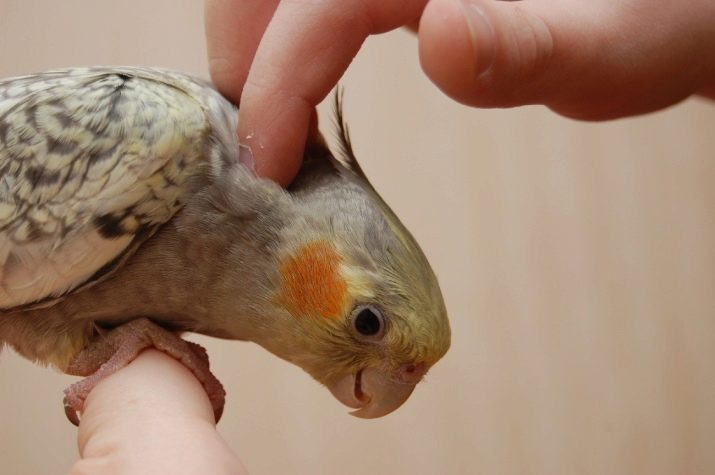
If the purpose of your purchase is to breed cockatiels, then choose adults aged 1.5 to 2 years. For healthy offspring, take birds from different litters so that there is no genetic relationship between them. Determining the sex of a nymph is a difficult task, the easiest way to do this is in birds with a traditional gray color, when the plumage clearly shows where the male and female are. In hybrid species, sex determination is difficult and an inexperienced breeder can easily overshoot.

The nuances of domestication
Acquiring a long-awaited pet is always a joyful and exciting event, but for a nymph, new living conditions are always stressful. Before establishing contact with the cockatiel, the pet should be given 2-3 days to adapt - at this time it is best to leave it alone, protecting it from harsh sounds, flashes of light, and odors. To calm the cockatiel, you can start talking to her in a low voice. So you start to accustom her to yourself and arouse interest.
You will soon see that the parrot is very sensitive to communication, and it is necessary for him. To make friends with a parrot faster, the bird cage should be at eye level. When the nymph is left alone, she can turn on the radio or TV, creating the sounds she needs.

Next, you need to teach the bird to stay with you outside the cage. To do this, the cockatiel is taken out of the cage and goes with her into a room with closed windows so that the pet does not fly out into the street. The bird is released, and when it sits on some object, they approach it and talk in a friendly manner. Over time, the nymph gets used to you and can be taught to sit on your hand.
The learning process is not quick, it is repeated over and over again and soon the bird will get used to doing what you expect from it.

For the taming process to go well, you need to praise your pet and give a treat for each success. Parrots love when feathers are stroked, picked up and given attention.
Maintenance and care
If you decide to get a cockatiel, you need to understand that breeding will be associated with certain financial costs. You need to buy a spacious cage, toys, two containers for food - dry and wet, a drinking bowl, a bathing container. In addition, you will need a small carrier in order to carry your pet to the veterinarian.

In the diet of a parrot, 65–70% should contain food in the form of grains, and the rest includes vegetables, fruits, boiled beans and corn, greens. There should always be fresh water in the cage, which should be changed immediately after contamination.
All raw vegetables and fruits must be washed before giving to the bird.
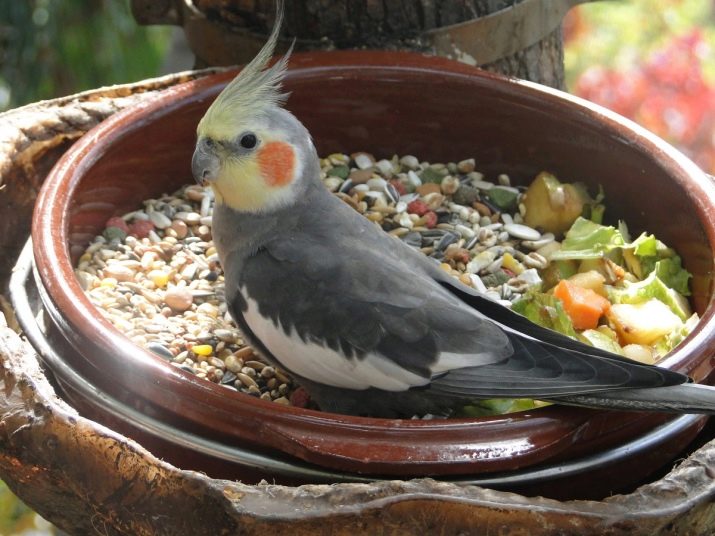
It is necessary to accustom the bird to water procedures - so that the cockatiel does not get sick, it is irrigated with feathers every few days. To do this, take a spray bottle and spray the pet with warm water 1-2 times on the feathers. Soon, at the sight of you with a spray in hand, the bird itself will begin to show activity in water procedures - it will spread its wings and wait for irrigation.

Cockatiels love to swim in trays of water, but such procedures are not carried out if the room is cool, otherwise the pet will catch a cold.
In the period from October to December, the parrot begins to molt - it sheds old feathers and grows new ones. Usually this time coincides with the breeding season. The pet becomes aggressive and experiences constant itching due to the change of plumage. At this time, he must be given vitamin and mineral supplements, and also protected from sudden changes in temperature and humidity.

For reproduction of parrots, it is necessary to equip the cage so that the home conditions resemble natural ones. You will need to make a house where they will equip the nest. For the female to lay a clutch of eggs, her diet must contain foods with a high calcium content.

Caring for parrots every day takes time: you need to feed them on time, monitor the availability of water, and regularly clean the cage.
The pet needs to trim its nails if necessary, provide bathing, show the veterinarian once a year and, of course, communicate regularly.
Diseases
If your pet gets sick, you will notice a change in its behavior. The parrot can start to rush around the cage, scream, be aggressive, or, on the contrary, become quiet and indifferent to everything. In this case, without wasting time, consult your veterinarian.

Common diseases of cockatiels.
- Inflammatory diseases - stress, fear, poor nutrition, improper temperature conditions weaken the body, and against this background, under the influence of bacteria and viruses, inflammatory processes of the beak and then the digestive system begin. White plaque appears on the mucous membranes of the tongue, the tongue swells, increases, the bird cannot eat, it is difficult for it to swallow and breathe. The pet refuses to eat, he loses weight, is apathetic, and this condition can quickly lead him to death. For diagnosis, a swab is taken from the bird's mouth and treatment is prescribed. At this time, feeding is carried out with a liquid mixture through a syringe.

- Growth and deformation of the beak - the wrong composition of food contributes to the fact that the keratinized parts of the beak do not grind off in a timely manner and grow. This happens on soft feed without the proper load on the splitting of hard seeds. Deformation of the beak over time leads to its incomplete closure and disrupts the process of eating. To fix this, perches from branches with bark are placed in the cage, mineral stones are placed to grind off the beak, and the bird is also transferred to a different diet, in which it will receive solid food with vitamins A, C and calcium.

- Scabies mite - the disease is transmitted with poor-quality food, through dirty objects of poultry use and from sick birds. The mite parasitizes in the area of the beak, cloaca, near the eyes and on the legs. The decorative appearance of the parrot deteriorates, the bird weakens and may die. For treatment, the cage and all objects in it are sanitized, and the affected areas of the bird are smeared every three days with aversectin ointment until complete recovery.

- The parrot plucks out its feathers - the cause may be infection, stress, lack of attention, pests, hormonal disruptions, poor living conditions. Veterinarians advise to exclude protein from the diet - cottage cheese, eggs - and add mineral supplements. In addition, the conditions of detention should be checked and, if necessary, changed. In the presence of feather eaters in the cage and the bird itself, an insecticidal treatment must be carried out.

- Gastroenteritis - the bird does not eat well, the droppings are liquid, green in color, with half-digested pieces of food and an admixture of blood, there may be vomiting. The parrot is nervous, constantly comes to the drinker and drinks a lot of water. The nature of the disease is infectious. For treatment, you need to sanitize the cells, exclude greens and sprouted grains from the diet. The food is mixed with the powder of Levomycetin or Ftalazol tablets, pieces of activated carbon or oak bark are added.

- Intestinal dysbiosis - an infectious disease that affects the intestines and is accompanied by liquid feces. For treatment, the bird is given "Polyphepan" for 5 days, which is mixed with grain feed. In addition, intestinal enzymes of the Linex preparation are added to the parrot's food for two weeks.

Dosages and treatments for your parrot are best discussed with your veterinarian. Self-medication may not bring the desired results and only aggravate the pet's condition.
Owner reviews
According to the owners of the cockatiel parrot, communication with a pet gives them a lot of positive emotions. Parrots are often equated with full-fledged family members over time. Cockatiels are friendly, outgoing and interesting in their behavior. Caring for them is a habit and is not as burdensome as it might seem at first. Children love these birds for their restless and cheerful disposition, and adults are happy to watch the pranks of their feathered favorites.

How to tame a cockatiel parrot, see the video below.








